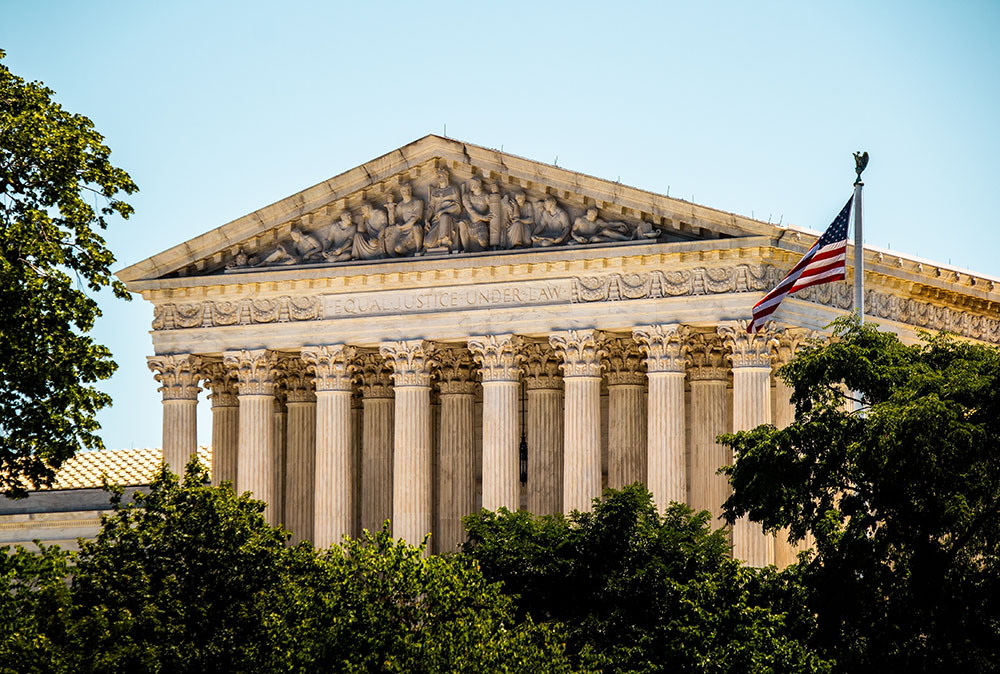
The U.S. Supreme Court in Washington, D.C. (Unsplash/Jimmy Woo)
The U.S. Supreme Court's decision last week in Allen v. Milligan, throwing out a redistricting map in Alabama that seemed designed to dilute the power of Black voters, was good news both for voting rights and for the court's legitimacy.
At issue was whether or not Section 2 of the Voting Rights Act, which aims to prevent the denial of the right to vote based on race, barred Alabama from precisely the kind of map the Republican legislature devised. That map packed a significant share of Black voters into a single district in such a way that only one of the state's seven congressional districts was majority-minority, even though Blacks make up 27% of the electorate in the state.
Just as bad, the rest of the Black vote was dispersed through the other six districts so that Black voters in those districts would not make a difference. Sure enough, in last year's midterms, Alabama sent six Republicans and one Democrat to the House.
In a decision that caught most court watchers by surprise, Chief Justice John Roberts and Associate Justice Brett Kavanaugh joined with the court's three liberal justices — Associate Justices Sonya Sotomayor, Elena Kagan and Ketanji Brown Jackson — to throw out the current map and uphold Section 2 of the Voting Rights Act.
Writing for the majority, Roberts said that the court's prior ruling in a 1986 case, Thornburg v. Gingles, which outlined a three-part test for applying Section 2, was still the law of the land. As the incomparable Amy Howe explained at Scotusblog:
The real issue before the court, Roberts explained, was not whether the lower court had applied existing law — Gingles — but instead "Alabama's attempt to remake our §2 jurisprudence anew" by focusing on computer-generated maps that are created without considering race at all. But that single-minded focus on the computer-generated maps — the so-called "race-neutral benchmark" — is inconsistent with the VRA's requirement that courts look at the entirety of the circumstances, Roberts observed. Moreover, he emphasized, such an interpretation would require a change to the Gingles' framework "that has been the baseline of our §2 jurisprudence for nearly forty years."
This did not exactly contradict Robert's assertion in the 2007 case Parents Involved in Community Schools v. Seattle School District Number 1 that "the way to stop discrimination on the basis of race is to stop discriminating on the basis of race." Instead, this is a step away from a naive conviction that colorblindness is the only appropriate means to the goal of a racially just society.
Advertisement
As Garrett Epps discussed at The Atlantic in 2014, if there is clear evidence that a particular law or map or policy was in fact crafted with the intent of disenfranchising minority voters, the discrimination needs to be remedied not by ignoring race, but by counteracting the initial, prejudicial law, policy or map.
As Howe explains, most court watchers were surprised because Roberts led the court in eviscerating Section 5 of the Voting Rights Act in the 2013 case Shelby County v. Holder and, in 2021, the court ruled 6-3 in the Brnovich v. Democratic National Committee case that watered down other Section 2 claims, but not the voter dilution claims at issue in this case.
So, the decision was good on the merits, but it was also good for the credibility of the court. If those Americans who distrust conservative legal theories, and the people who promote them, think the Supreme Court will never even give them a hearing, they will lose confidence in the court as an institution. It turns out, many decisions are not being decided by a 6-3 conservative majority, or even by a 5-4 conservative majority as this listing at The New York Times demonstrates.
It is hard to overstate how vital it is that the court be seen as legitimate — and, of course, that it lives up to that designation. None of us know what pressures will be brought to bear on the political branches in the near future: the indictment for former President Donald Trump, the willful obfuscation of the issues surrounding the former president's allegedly criminal behavior by leading Republicans and Fox News, challenges to election results, all seem guaranteed to end up before the Supreme Court in one way or another. If they are incapable of rising above partisan politics, and are not seen to have so risen, our democracy is deeply imperiled.
The fact that the current court will largely issue conservative decisions is one thing. You may agree with that ideological leaning or not. But the fact that the justices are not moving in lockstep is the most vital fact in the life of the American republic at this moment.







